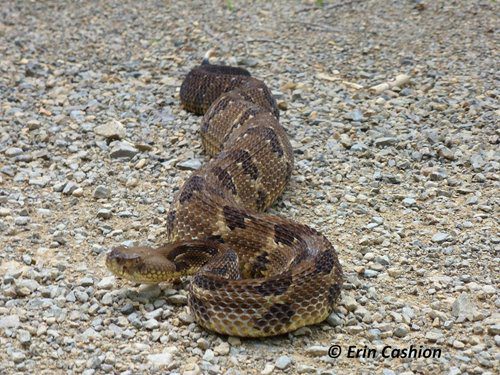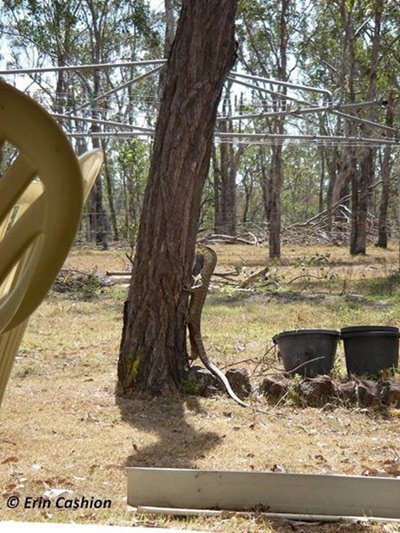Click here for Part I of this two-part blog series!
So all this tick stuff is great news and all, but what does this all have to do with rattlesnakes?
I’m glad you asked!
Because their main prey are rodents that carry Lyme disease.
Recent findings by University of Maryland researchers demonstrate that the Timber Rattlesnake (Crotalus horridus) may indirectly benefit humans by keeping reservoir hosts populations in check. Timbers are listed as endangered in Ohio and five other states, mainly due to habitat loss and fearful humans that kill them.
Although not addressed in the study, it’s worth mentioning that the Northern Copperhead (Agkistrodon contortrix mokasen) and many other nonvenomous snakes–plus Ohio’s other endangered rattlesnake, the Eastern Massasauga (Sistrurus catenatus catenatus)–also eat reservoir hosts!
There is mounting evidence that climate change will both expand the range of ticks and increase the amount of time that ticks are able to feed throughout their life cycle. Both will contribute to the persistence of the Lyme spirochete and other vector-borne diseases in the environment, so it’s pretty likely that well see an increase the rate at which people contract them. Luckily, nature has already provided us with a solution!

Our secret weapon against Lyme, a lovely and mild-mannered (and very frightened!) Timber Rattlesnake. She’s puffed herself up and is preparing to retreat (notice she is neither rattling nor threatening to strike). After I took this photo I moved her off the road with a trekking pole so she wouldn’t get smooshed, and she quietly went on her way.
Venomous snakes in particular benefit humans indirectly in other ways. It’s old news that a protein isolated from Southern Copperhead (Agkistrodon contortrix contortrix) venom slows or prevents breast cancer tumors from metastasizing (spreading to other parts of the body) and slows the growth of the blood vessels feeding the tumors. Neurotoxins isolated from snake venom may have applications in the treatment of neurological disorders such as Parkinsons, Alzheimers, multiple sclerosis, and pain management. So perhaps we should see them as less a slithering menace, and more like a legless pharmacopoeia.
If you’re an urban Ohioan, the chances that you will find a venomous snake on your property are pretty tiny. If your home is in rural Ohio, well… the chances are still pretty dang small! So if you see a snake in your yard, it’s very likely to be completely harmless, AND it’s probably there to provide the helpful service of eating the disease-ridden mice running around in your walls, and then have a nice nap in your brush pile. (If you get rid of the mice and brush piles, the snakes won’t see your property as a good place to stay.)
Alternatively, consider your property something to share with other creatures, and take pride in the things that feel safe enough to reside there with you. Give a snake the same consideration that you’d give any other wild creature in your yard, be it a hawk, a dragonfly, or a robin–just sit back and relax, and let them do their thing! They certainly are not interested in you.

The 4-foot Lace Monitor living under our kitchen in Australia. He was big and kind of scary, but he was also eating the rats!
Most snakes are relatively small, and thus make a good snack for a lot of animals farther up the food chain–hawks, foxes, raccoons, other snakes, and felines come to mind. So if you’re a snake, you can safely assume that anything bigger than you is probably going to eat you. People generally don’t eat snakes on the regular, but the snakes don’t know that. All they see is something bigger than me. So keep in mind, if you see a puffed up, coiled, hissing, or striking snake–it is literally afraid for its life and desperately wants to get away. To quote Clifford H. Pope, “Snakes are first cowards, then bluffers, and last of all warriors.”
Finally, the vast majority of snake bite situations arise out of a person actively harassing the snake. Like humans, a snake may attack if it fears for its life. But unlike humans,
So if you leave it alone, guess what–it will leave you alone right back! For more information on venomous snakebite, I strongly recommend this in-depth and well-researched blog post.
 Image by Urban Jungles Radio (http://urbanjunglesradio.webs.com/)
Image by Urban Jungles Radio (http://urbanjunglesradio.webs.com/)
Snakes are needlessly vilified by popular culture, especially in the United States. It’s time we moved past this ill-informed attitude and accepted them as a vital puzzle piece in our human ecosystem. Our lives could very well depend on it.
“I recollected that her eye excelled in brightness, that of any other animal, and that she has no eye-lids. She may therefore be esteemed an emblem of vigilance. She never begins an attack, nor, when once engaged, ever surrenders: She is therefore an emblem of magnanimity and true courage. As if anxious to prevent all pretensions of quarreling with her, the weapons with which nature has furnished her, she conceals in the roof of her mouth, so that, to those who are unacquainted with her, she appears to be a most defenseless animal; and even when those weapons are shown and extended for her defense, they appear weak and contemptible; but their wounds however small, are decisive and fatal. Conscious of this, she never wounds ’till she has generously given notice, even to her enemy, and cautioned him against the danger of treading on her.”
–An American Guesser (plausibly identified as Ben Franklin), on supporting the adoption of the Rattle-Snake as a symbol of the 13 Colonies, published in the Pennsylvania Journal on December 27, 1775. The entire letter is posted here.